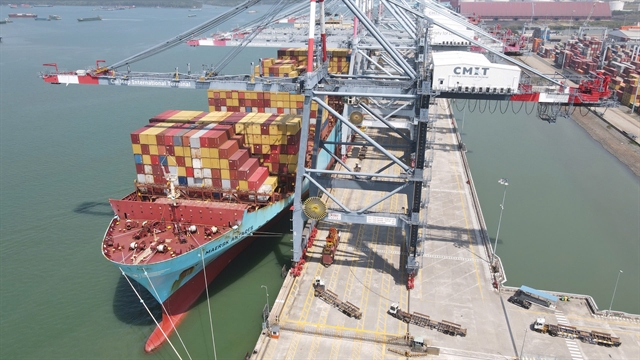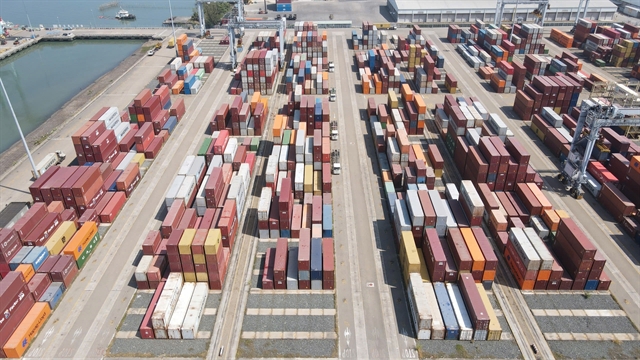First Gemini cooperation vessel Maersk Antares on the night of February 7 departed from Cái Mép International Terminal (CMIT) in Bà Rịa-Vũng Tàu Province after successfully and safely handling nearly 11,000 TEUs of cargo and empty containers.

BÀ RỊA - VŨNG TÀU — The Maersk Antares, the first vessel under the Gemini Cooperation, departed from Cái Mép International Terminal (CMIT) in Bà Rịa-Vũng Tàu Province on the night of February 7 after successfully and safely handling nearly 11,000 TEUs of cargo and empty containers.
Arriving at CMIT on February 6, the vessel is part of the alliance’s plan to operate two mainline vessels and one feeder vessel at the terminal. This marks the launch of Gemini Cooperation’s TP6/WC1 service route, achieving an impressive berth productivity of 172 containers per hour.
Gemini Cooperation, a strategic partnership between Maersk and Hapag-Lloyd, officially took effect on February 1, 2025, with the goal of achieving more than 90 per cent schedule reliability once the entire network is fully operational. This requires ports to maintain high-speed cargo handling, enabling vessels to adhere to precise schedules. The alliance aims to establish a long-term shipping partnership, providing a highly reliable and flexible maritime network.
Customers will benefit from improved service quality, shorter transit times across major port corridors, and access to some of the world's most well-connected maritime hubs. Additionally, Maersk and Hapag-Lloyd will leverage their scale and network to reduce costs and offer more competitive shipping rates.
In Việt Nam, CMIT has been selected as the exclusive main port for the Gemini Cooperation. With 14 years of operational experience, CMIT has remained a trusted choice for Maersk and Hapag-Lloyd. The terminal is set to handle two mainline vessels and one feeder vessel weekly under the new alliance. Key factors such as high, stable, and safe cargo-handling productivity have reinforced CMIT's credibility among its global partners.
With support from APM Terminals, VIMC, and Sài Gòn Port, CMIT has recently invested in and received its seventh quay crane, enhancing its operational capacity and improving loading and unloading productivity to meet the growing demands of customers. Currently, CMIT handles eight weekly service routes, connecting Việt Nam with key global markets, including the Americas, Europe, the Mediterranean, the Middle East, and intra-Asia.
Both Maersk and Hapag-Lloyd have committed to decarbonising their fleets, with Maersk aiming for net-zero emissions by 2040 and Hapag-Lloyd targeting 2045. The launch of the Gemini Cooperation follows Maersk’s exit from the 2M Alliance and Hapag-Lloyd’s withdrawal from THE Alliance in early 2025.
The Gemini Cooperation will operate a fleet of approximately 290 vessels with a total capacity of 3.4 million TEUs, with Maersk contributing 60 per cent and Hapag-Lloyd 40 per cent. The network will include seven trade corridors and 26 mainline services, consisting of 14 services in Europe, four in the Middle East, 13 in Asia, and one in the Gulf of Mexico.
The selection of CMIT as a key port in this new partnership is expected to enhance connectivity within the Cái Mép-Thị Vải deep-water port cluster and strengthen its role in international shipping. This development will increase import-export volumes while creating opportunities for logistics cooperation, infrastructure improvements, and overall growth in Việt Nam’s maritime industry.
As of February 2025, three major global shipping alliances will remain following recent restructuring. Premier Alliance, formerly known as THE Alliance, will include ONE, Yang Ming, and HMM. Ocean Alliance will continue to comprise CMA-CGM, COSCO Group, OOCL, and Evergreen. The Gemini Cooperation will consist of Maersk and Hapag-Lloyd.

Bernadette Chan, General Director of Cái Mép International Terminal (CMIT), announced that total container throughput at Cái Mép ports reached nearly 6.5 million TEUs in 2024, reflecting an impressive 33 per cent growth rate.
“As the premier deep-water gateway port of southern Việt Nam, CMIT is optimistic about further expansion in partnership with Gemini, anticipating continued growth in 2025,” she said.
She reaffirmed CMIT’s commitment to delivering high operational efficiency and safety, both of which are essential for achieving the Gemini Cooperation’s objectives. By maintaining top-tier productivity, CMIT has strengthened its position as a trusted partner within the alliance, facilitating better resource allocation and operational planning.
The collaboration between CMIT and Gemini will support all stakeholders in optimising their operations while contributing to the rapid expansion of Việt Nam’s export-import market. The Gemini Cooperation officially took effect worldwide on February 1, marking a significant restructuring in global shipping networks.
According to the alliance, a total of seven direct services will call at the Cái Mép-Thị Vải port cluster from February onwards, excluding MSC vessels that exchange slots with other shipping lines. Experts and port operators predict that these shifts in shipping alliances will lead to an increase in direct services to the US from Cái Mép-Thị Vải, further enhancing its strategic importance.
Given its deep-water port capabilities, the port cluster is poised to become an even more attractive destination, particularly if new alliances prioritise Asia-Europe trade routes. This is considered an encouraging development for the region’s maritime industry.
CMIT has played a pioneering role in advancing the Cái Mép-Thị Vải port cluster, having successfully accommodated some of the world's largest container ships. The terminal achieved key milestones in 2017 when it received a 194,000 DWT vessel and in 2020 when it handled a 214,000 DWT vessel.
It remains one of the select few ports worldwide capable of accommodating such ultra-large vessels. This achievement has paved the way for Việt Nam’s Ministry of Transport and the Vietnam Maritime Administration to grant operational approval for other deep-water terminals in Cái Mép-Thị Vải to handle similarly large ships, further reinforcing the region’s role in global shipping. — VNS





